Sales funnels are key to driving conversion rates and growing your business. This article will answer the following questions: what is a sales funnel and how can you create one?
Your sales funnel might not convert 100% of people who come across your brand. However, it can increase your chances of converting those who are genuinely interested.
Read on to discover the benefits of sales funnels, find sales funnel examples, and learn how to build one for your business.
What is a sales funnel?
A sales funnel is a visual model that outlines the stages a customer goes through on their way to a purchase.
As customer journeys are often non-linear, the goal of a sales funnel is to shorten the path to purchase. That’s because it creates a predictable flow of interactions, guiding the customer toward a decision.
Sales funnels are often confused with email funnels. While both serve to guide leads through the buying process, email funnels specifically use email as the primary medium to deliver content, engage with leads, and move them through the stages of the funnel. In contrast, sales funnels utilize multiple channels and strategies beyond email, focusing on the overall customer journey.
Why are sales funnels important?
Most businesses benefit from having a sales funnel. Here's why.
Increased control over your sales process
A sales funnel adds a layer of predictability to your potential customer’s journey. Instead of simply following your customers, you actually get an opportunity to direct their actions.
With an effective sales funnel, you can proactively guide your leads toward the resources they need at each stage. This makes their decision-making process smoother.
Easier to scale
Sales funnels ensure the consistency needed to automate parts of your sales process. This frees you from manually managing each stage of the buying process.
More efficient lead sorting
A sales funnel acts as a powerful filtering mechanism. By defining your ideal customer and creating tailored content for each stage, you’ll naturally attract the right prospects.
Data-driven decisions
Sales funnels give you a full view of where prospects drop off and how your sales team performs at each step. This translates into clear, actionable metrics that empower you to make strategic decisions.
Further reading: Top 7 Sales Forecasting Tools for SMBs
What are the main sales funnel stages?
Each sales funnel may look very different. It depends on the length and complexity of your sales cycle. However, most include the same main stages.
The simplest framework to understand the customer's position within the funnel is the TOFU, MOFU, BOFU breakdown:
- Top-of-the-Funnel (TOFU): Potential customers become aware of their problem and are actively researching solutions.
- Middle-of-the-Funnel (MOFU): Customers weigh their options and seek information that will help them compare your solution to the competition.
- Bottom-of-the-Funnel (BOFU): Customers show strong interest and are close to a decision. The focus is to remove final barriers and make the purchase process seamless.
Another common way to visualize the sales funnel is with these four stages:
- Awareness
- Interest
- Intent
- Purchase
These stages are part of the marketing funnel too. In inbound strategies, the top of the funnel is heavily influenced by marketing efforts (e.g. content creation, lead generation campaigns). Sales teams rely on marketing to generate qualified leads before taking over.
Later, we’ll share more examples of sales funnels that fit different strategies. First, let’s look at each stage of the traditional sales funnel.
1. Awareness
This is where a customer first realizes they have a problem or a desire they want to fulfill, but they might not even know your solution exists yet.
Your job here is to cast a wide net. Blog content, targeted social media ads, or search engine optimization (SEO) are all ways to attract early-stage potential buyers.
2. Interest
In this stage, potential customers are actively researching options. They’ll express interest in educational resources, such as webinars, whitepapers, etc.
As they learn more, they’ll start weighing you against competitors. Make this process easy for them by producing side-by-side comparisons, featuring your products on a review website, and offering interactive demos or free trials.
Creating an effective sales email sequence can also guide your customers through the sales funnel, gradually moving them from interest to the final purchase.
3. Intent
Here, potential buyers have moved from just considering a purchase to showing strong signals they're ready to buy. They might have some lingering doubts, so address this head-on.
Use case studies to boost confidence, establish social proof, and demonstrate how your solution has delivered results. Offer a demo of your product or a free consultation to showcase its value.
4. Purchase
If a buyer has reached this stage, they've decided your product or service is the answer. However, the deal isn't quite closed yet.
This is your moment to remove any final barriers and reassure the customer. You might add a FAQ section to address potential concerns about future support, terms and warranties, the payment process, and delivery timelines.
Note: Customer journeys rarely follow the same neat path. They may revisit stages, jump back and forth, or get stuck for a time. Your sales funnel needs to be adaptable enough to account for this non-linear behavior.
Further reading: 8 Winning Strategies to Generate Warm Leads
Sales funnel examples
Your sales funnel depends on your business model and sales strategy. Here are two sales funnel examples for inbound and outbound strategies.
Inbound sales funnel
The inbound sales funnel is about attracting potential customers who are already seeking solutions or information related to what you offer.
This type of funnel thrives on a strong partnership between marketing and sales teams. Marketing focuses on generating interest through high-value content. Then sales takes over to guide prospects through their decision-making journey.
Here's what this might look like in practice.
1. Drive traffic [TOFU]
Drive potential customers to your site through SEO, social media, or targeted ads that address the specific pain points your product/service solves.
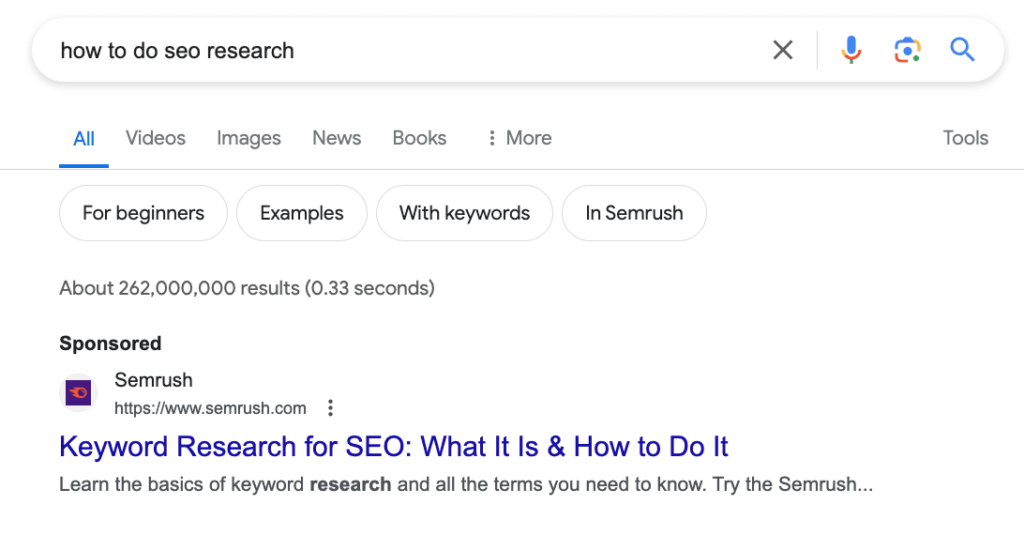
An entry point into the inbound sales funnel
Note: Because people don’t move neatly through the funnel, it’s a good idea to optimize each piece of content for conversion — even if it’s created for an early awareness stage.
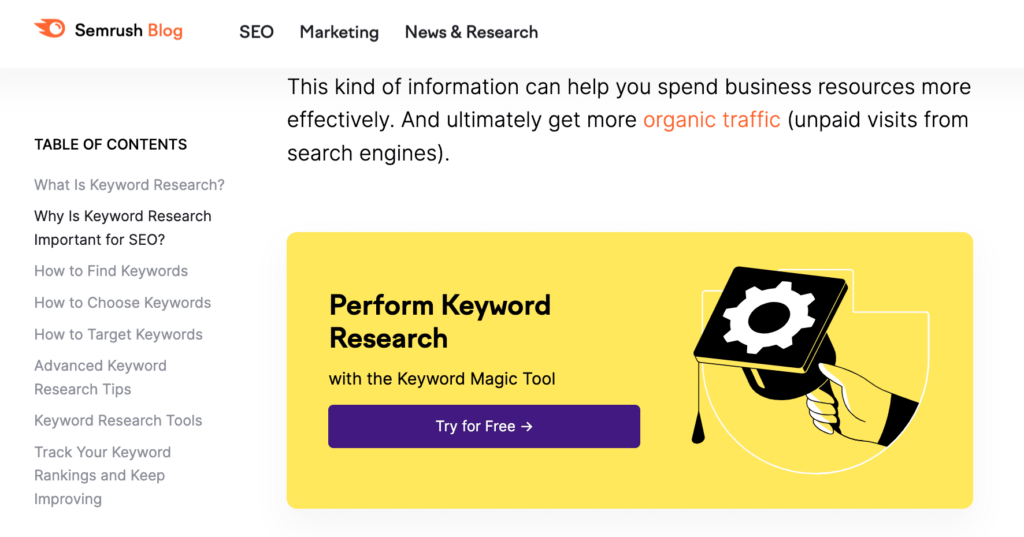
An example of a conversion CTA in TOFU content
2. Educate [TOFU]
At this stage, give leads resources that establish you as an authority and build trust. Think about original research, studies, in-depth guides, etc.
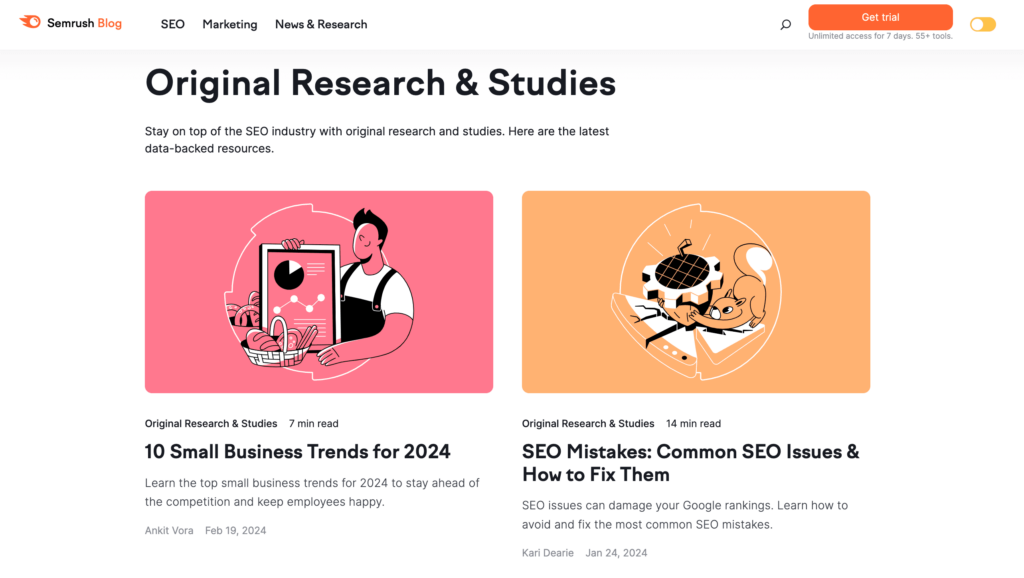
Educational content
3. Convert into leads [MOFU/BOFU]
At this point, prospects are actively considering your solution alongside competitors. Help them make a confident decision with comparison charts, customer testimonials, or opportunities to speak with a sales rep.
You want to turn passive interest into active engagement. The goal is to convince potential customers to give you their contact information in exchange for something they genuinely value.
This is where sales and marketing work together. The sales team's understanding of the ideal customer will help marketing create an appealing lead magnet. The lead magnet, in turn, is crucial to attracting the right leads.

A lead magnet by Semrush
You may be able to capture thousands of contacts with a lead magnet on a viral topic. But if those contacts aren't a good fit for your brand, it won't translate to sales. The key is to strike the balance between generating excitement and appealing to your ideal customer profiles.
Further reading: Agency Case Study: Using Email Sequencing to Improve Lead Generation
4. Nurture to close [BOFU]
Now that you’ve generated leads, guide them toward a purchase decision with personalized outreach campaigns. Set up email sequences that deliver relevant content based on past interactions or specific characteristics.
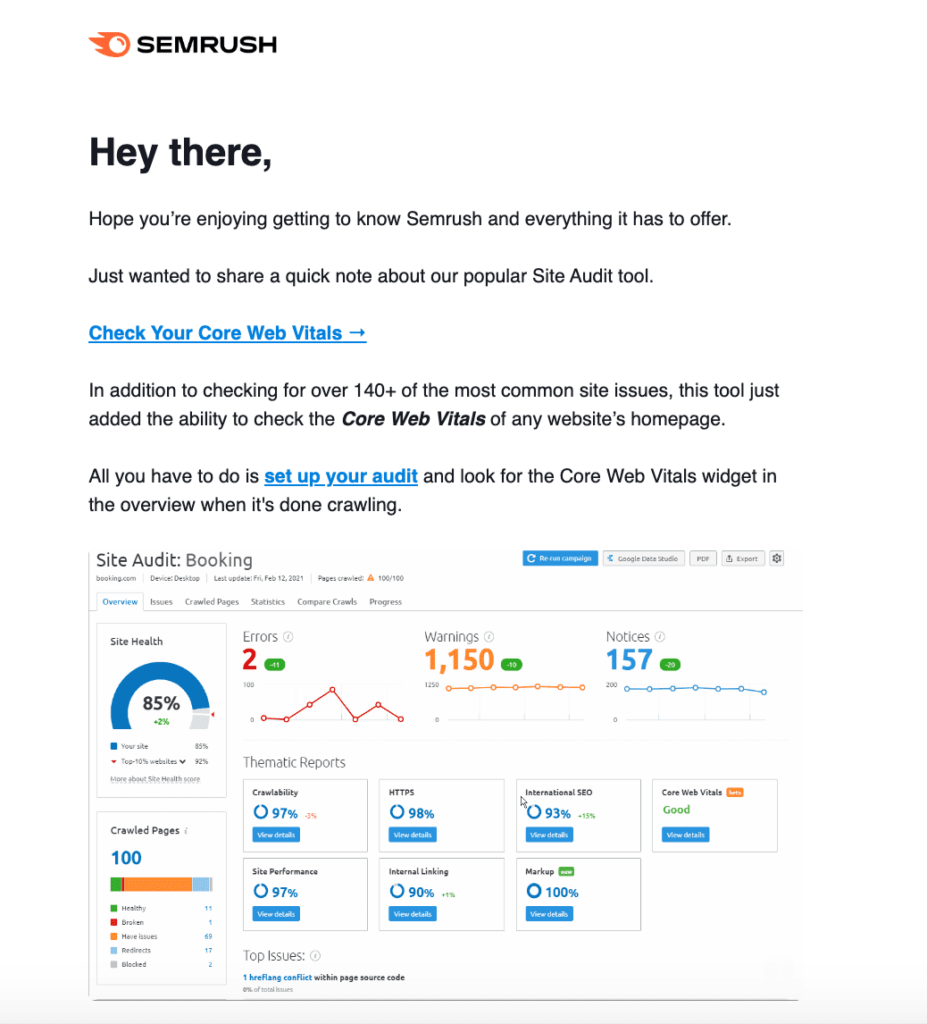
A lead nurture email example
For highly qualified leads (e.g. prospects who consistently interact with email marketing campaigns or actively use your free trial), sales reps take the lead. You might offer a demo or a consultation to address prospects’ specific needs.

The Semrush demo email isn’t public, but the follow-up email above follows the same approach.
5. Secure purchase [BOFU]
Nearing the purchase decision, leads may need a final push. Here, offer tailored solutions and/or limited-time incentives like discounts, special offers, or free trial extensions.
Finally, ensure clarity and transparency by clearly outlining payment terms, refund policies, and any other details that could cause last-minute hesitation.
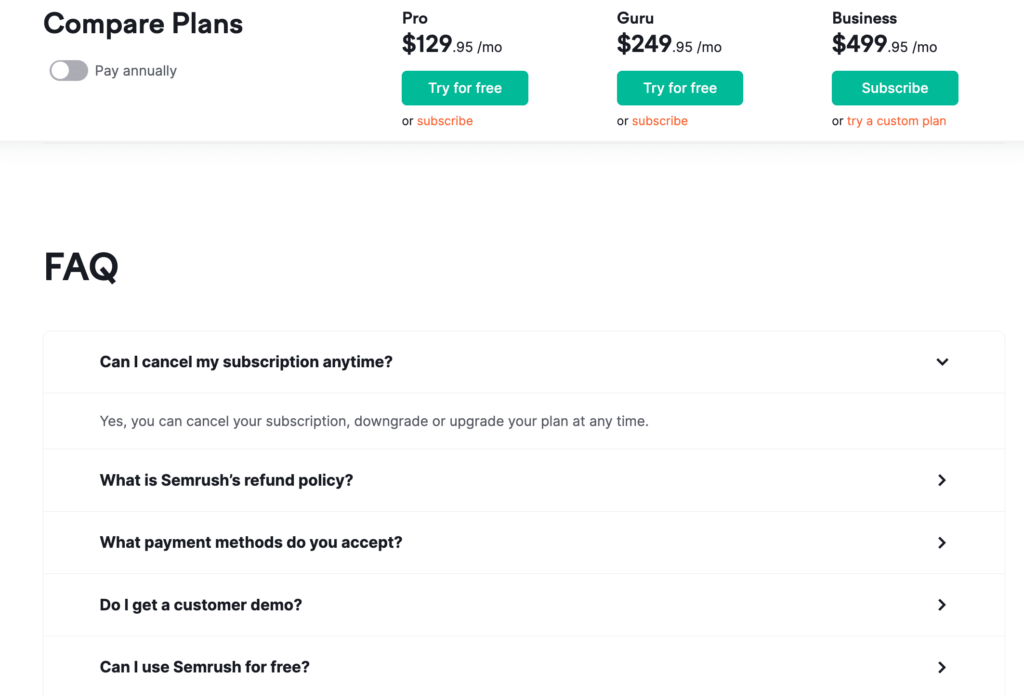
A FAQ section on the pricing page
Remember: the customer journey doesn't end with the sale. Account managers or customer success reps will need to provide onboarding and ongoing support. The salesperson needs to ensure a smooth handover, creating a positive customer experience.
Further reading: 6 CRM Best Practices for Marketing & Sales Teams
Outbound sales funnel
The outbound sales funnel focuses on proactive outreach to potential customers. This funnel relies on targeted prospecting, personalized engagement, and persistence from the sales team.
Here's a breakdown of the typical stages in an outbound sales funnel.
1. Prospect [TOFU]
The outbound sales funnel starts with prospecting. It involves identifying high-value target companies and the individuals within those companies who best match your ideal customer profile (ICP).
In B2B, LinkedIn is a go-to tool for identifying and connecting with prospective customers. B2B sales reps use its search capabilities to pinpoint companies and individuals that closely match their ideal customer profile by factors like job title, company, industry, location, and more.
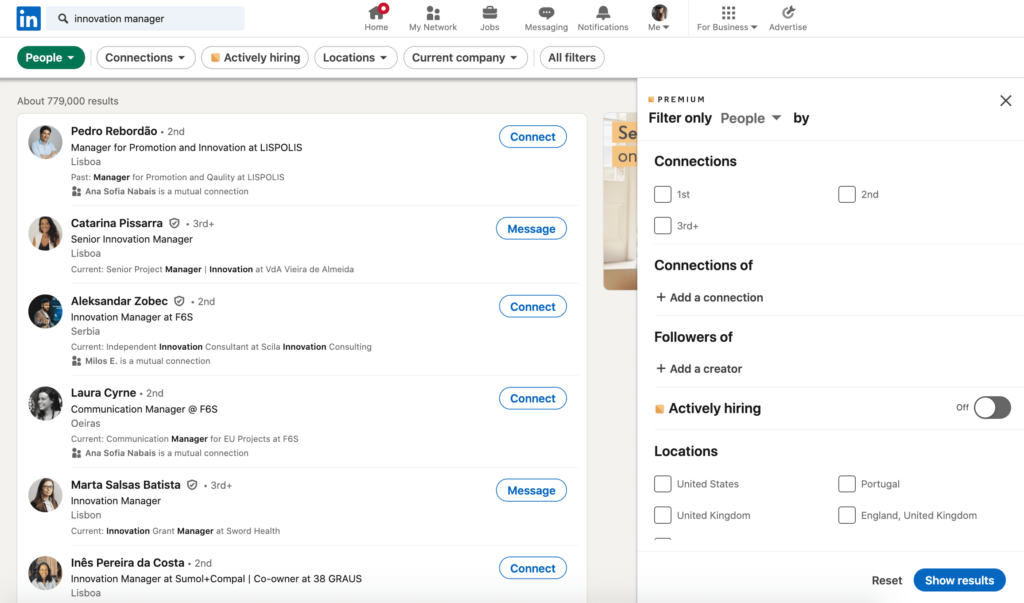
Prospecting on LinkedIn
You may also go a step further and source your LinkedIn prospects’ emails through a tool like Hunter.io or Lusha.
What about B2C? While B2C companies rely on outbound sales less frequently, it remains a good strategy, especially for high-ticket products or services.
B2C sales reps often source potential customers through third-party data providers. Alternatively, you can use audience insights generated through targeted social media ad campaigns.
2. Connect [TOFU]
Once you have a targeted prospect list, the next step is to initiate contact. Reach the prospects using the contact information you’ve sourced earlier.
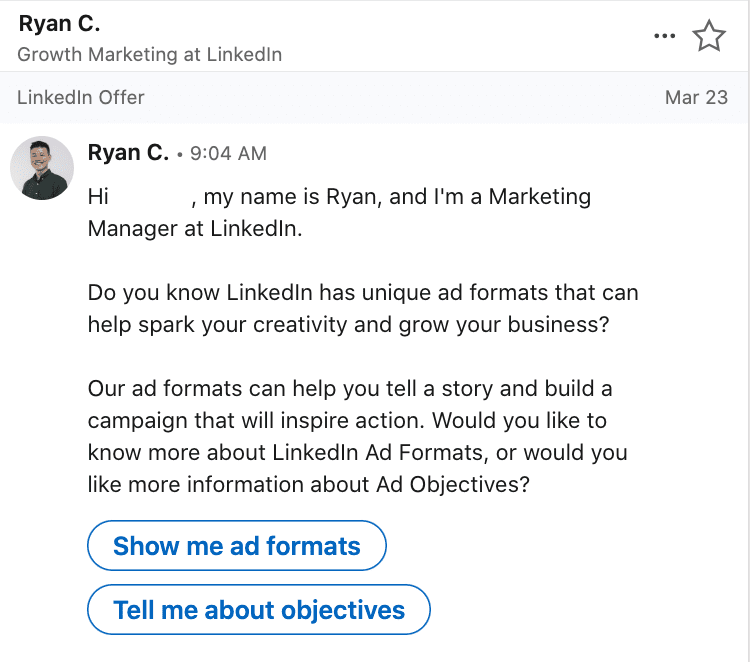
A cold sales outreach message
Whether you reach out over LinkedIn InMail, email, or social media, use personalization to capture their interest. In this stage, you need to engage them in a conversation — so avoid pitching right away.
If you succeed, you’ll be able to further qualify them as leads and tailor your messaging in the next stages of the sales funnel.
Further reading: 8 Meeting Request Email Templates
3. Qualify [MOFU]
Once a prospect responds to your initial outreach, you'll hopefully have enough data to determine if they’re a good fit.
For more complex sales processes, you might need a discovery call. Use open-ended questions to delve deeper into their specific pain points, budget, decision-making process, and authority within the company. These questions are a part of the BANT qualification framework.
4. Demo & Pitch [BOFU]
If the lead fits your ICP, the next step is a more in-depth conversation — either a discovery call (if you haven't had one yet) or a personalized demo.
Be sure to tailor the demo to address their specific problems. Your goal is to let the prospect see firsthand how your product or service can address their challenges.
After the call, don't let the conversation fade away. Send a follow-up message summarizing the key points discussed. Reiterate the value proposition, and potentially outline the next steps (like a formal proposal or additional resources).
5. Close [BOFU]
Prospects who reach this stage have shown strong interest and fit. Now it's time to close the deal. Prepare a clear proposal outlining your solution, pricing structures, and terms of the agreement. Be open to negotiation as you work towards mutually agreeable terms.
Once all sides agree, draft a comprehensive contract that protects both parties and defines the scope of the engagement.
Finally, set the foundation for a successful partnership. Communicate expectations for the onboarding process and ongoing support. Once active, transition the client to their dedicated account manager.
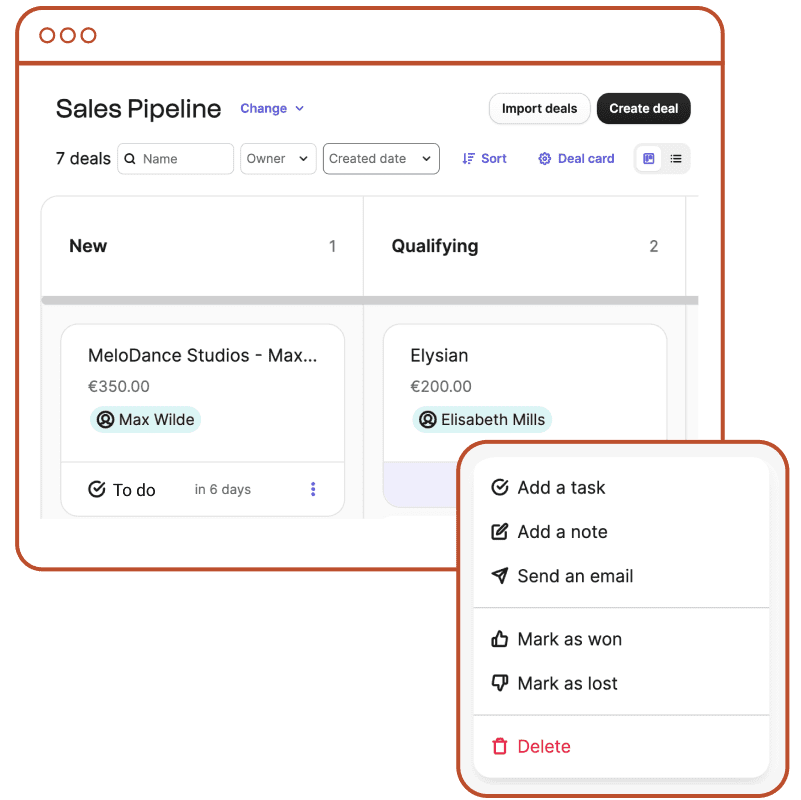
Manage your outbound sales funnel with Brevo’s custom deal pipelines
How to create a sales funnel
Ready to create an effective sales funnel? Here are the main steps.
1. Consider creating several sales funnels
Even within a single business, different products, target audiences, or sales strategies might call for distinct funnels.
For instance, you may consider creating separate funnels for different product offerings. This is useful especially if they vary significantly in price point, complexity, or the decision-making process involved.
Let's say you offer project management software with both a basic, self-serve plan for small teams plus a robust, customizable solution for large enterprises.
Small business content would focus on ease of use, quick setup, and common pain points like missed deadlines. Enterprise content, on the other hand, might highlight scalability, security, integrations, and thought leadership.
2. Create a sales funnel template
When you’ve defined your sales funnels, sketch out a simple visual of the main stages. You could use the standard TOFU/MOFU/BOFU breakdown or another model that fits your sales process. The format doesn't matter as much as outlining the key stages.
Think of this as a blueprint you'll fill in with specific actions and content later. Here are some options:
- Use Canva or other design tools to access sales funnel templates. This is great for a high-level overview.
- Create a spreadsheet to map out sales funnel stages, alongside columns for potential content, sales actions, and even data-tracking fields.
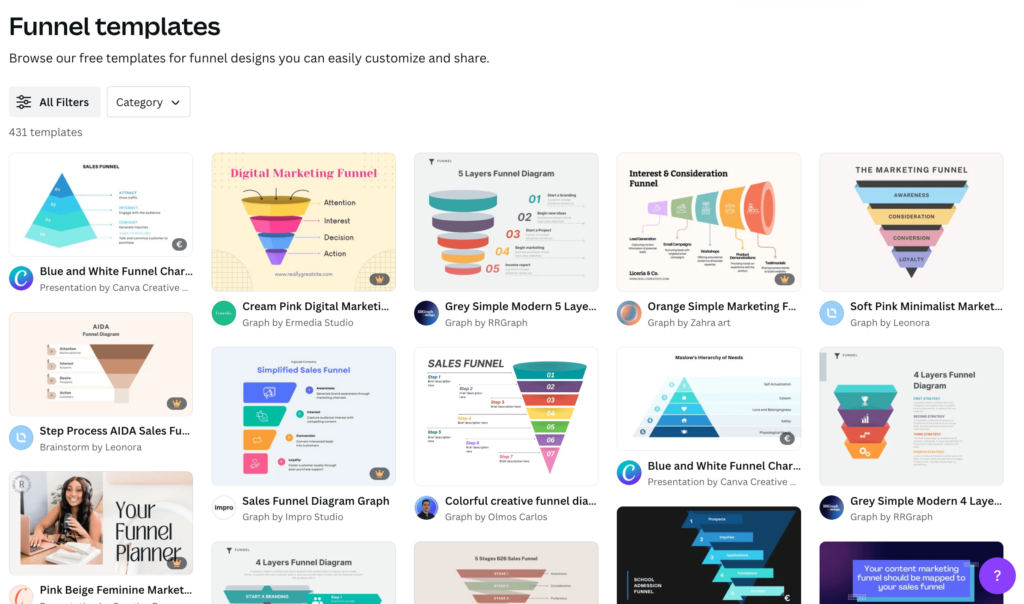
Examples of sales funnel templates available in Canva
3. Map out the customer journey touchpoints and funnel stages
Analyze each stage to learn how your ideal customer interacts with your brand throughout their decision journey. Start by defining an entry point, then determine each step your ICP would take from there.
Remember, you're not mapping the journey for every casual browser. Focus on creating a narrow path for people that fit your target audience.
Here's what to consider for each touchpoint:
- Customer actions: What specific actions are they taking (searching keywords, reading reviews, attending webinars, etc.)?
- Customer mindset: What questions are they asking? What pain points do they face? Do they have any hesitations?
- Your response: How can you address their needs at this point? What content, resources, or sales outreach tactics can guide them toward the next stage?
Mind that each touchpoint will require a long-term strategy. For example, if you know your customers turn to third-party comparison websites in the interest stage, focus on building a strong presence on relevant platforms.
4. Connect customer data to your CRM
A customer relationship management (CRM) system is the central hub of your sales funnel. After you capture the lead’s contact details, this is where you’ll store their interaction history (e.g. website visits, content downloads, email engagement).
All-in-one CRM solutions like Brevo centralize data from across your entire marketing and sales ecosystem. This makes lead tracking, segmentation, and identifying critical touchpoints much easier.
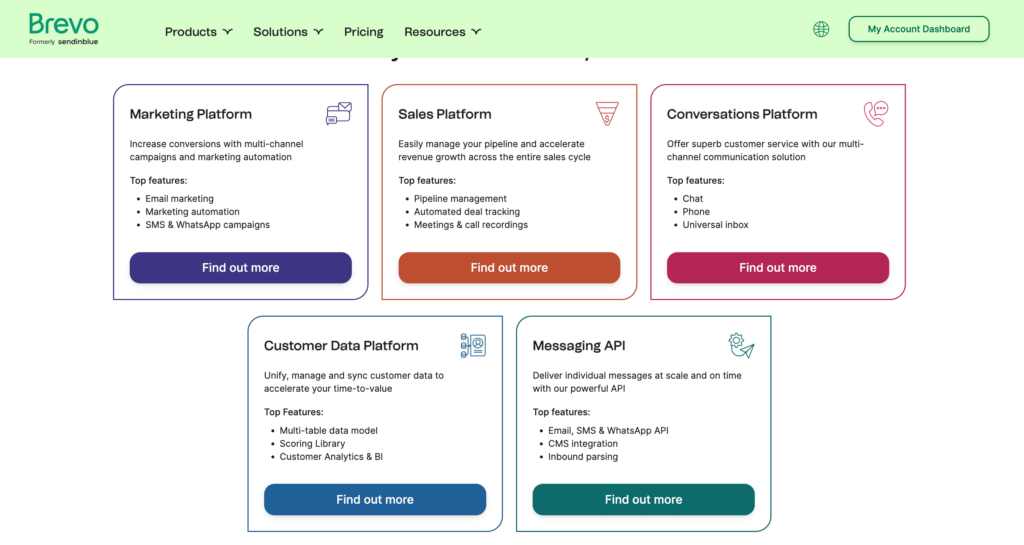
Brevo CRM suite
Brevo’s free plan includes sales automation, pipeline management, and email marketing. You’ll be able to track all your leads’ activities and even automate certain stages of your sales funnel.
5. Set up automated workflows to connect the touchpoints
Now that you have a single customer view, it's time to make your funnel work for you. With automation, it’s easier to scale your sales efforts and maximize results.
Here are a few sales automation workflows you can build in Brevo:
- Lead generation campaigns [TOFU/MOFU]: Create lead capture forms and landing pages with the drag-and-drop editor. Then save lead data right in your CRM. If you have several pipelines, save new leads to the right contact list automatically.
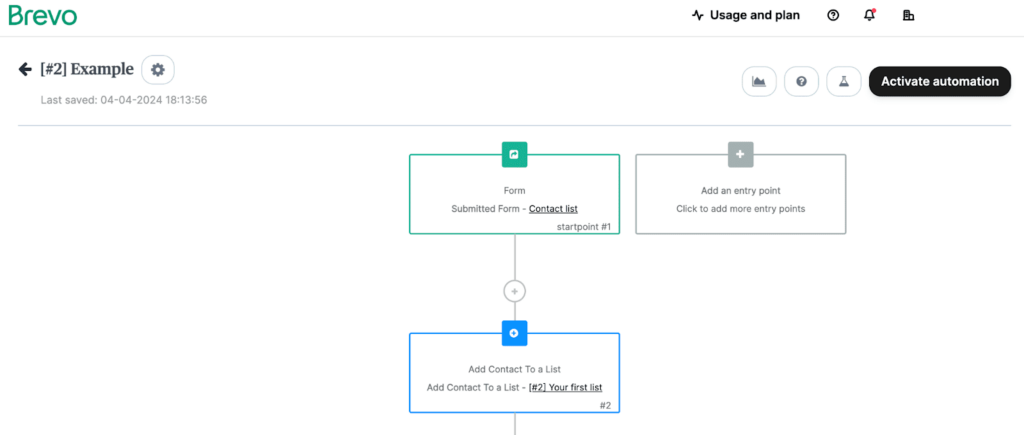
Lead generation automation in Brevo
- Nurture campaigns [TOFU/MOFU/BOFU]: Launch automated email sequences for any scenario. Trigger nurture campaigns based on various events, such as a new signup, reaching specific qualification criteria, or a particular action on your website.
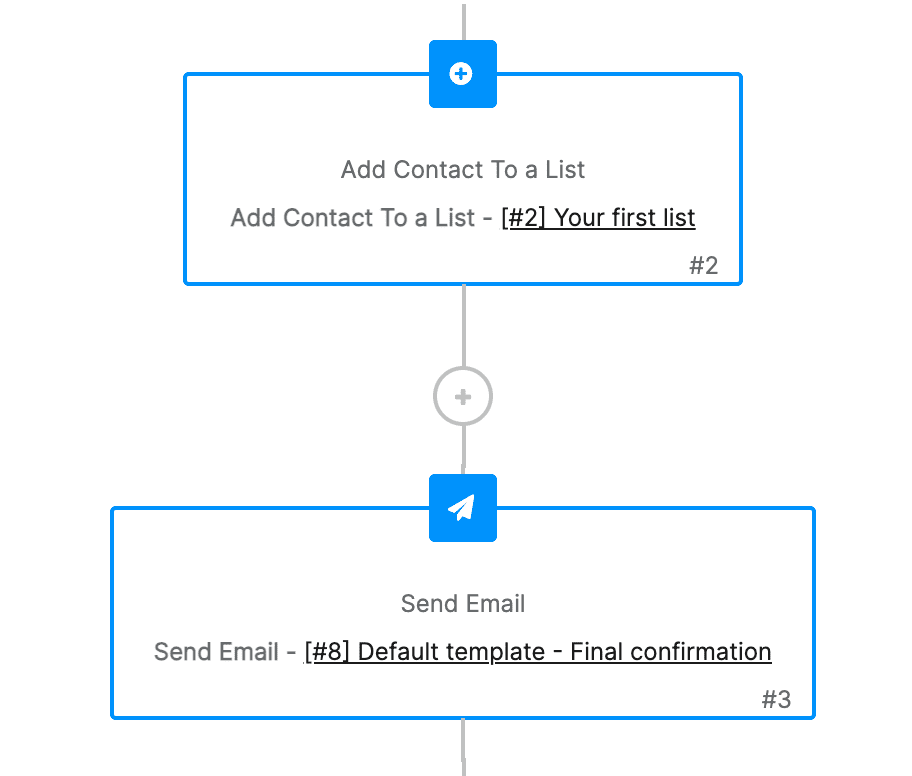
An automated email campaign in Brevo
- Lead qualification and segmentation [MOFU/BOFU]: Use lead scoring to identify the most promising prospects. Assign point values to customer actions, such as visiting pricing pages or requesting a product demo. Then segment leads based on their scores.
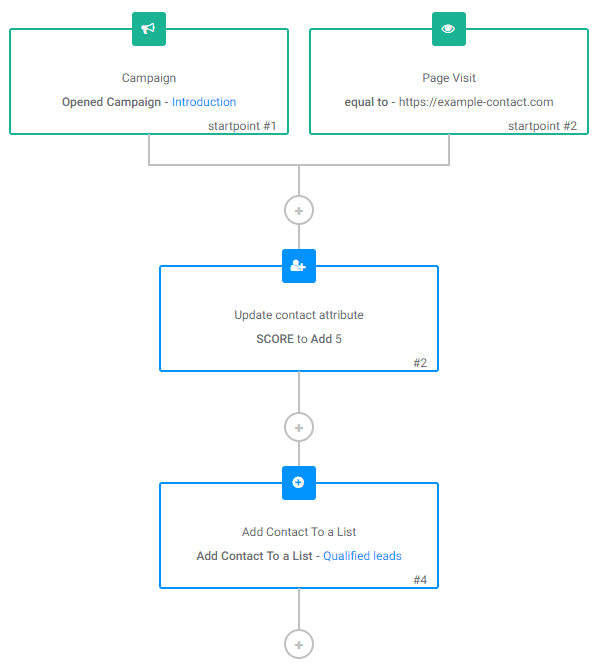
Lead scoring automation in Brevo
- Automated deal creation and pipeline management [BOFU]: Based on qualification criteria, automatically create deals in Brevo Sales Platform and assign them to sales reps.
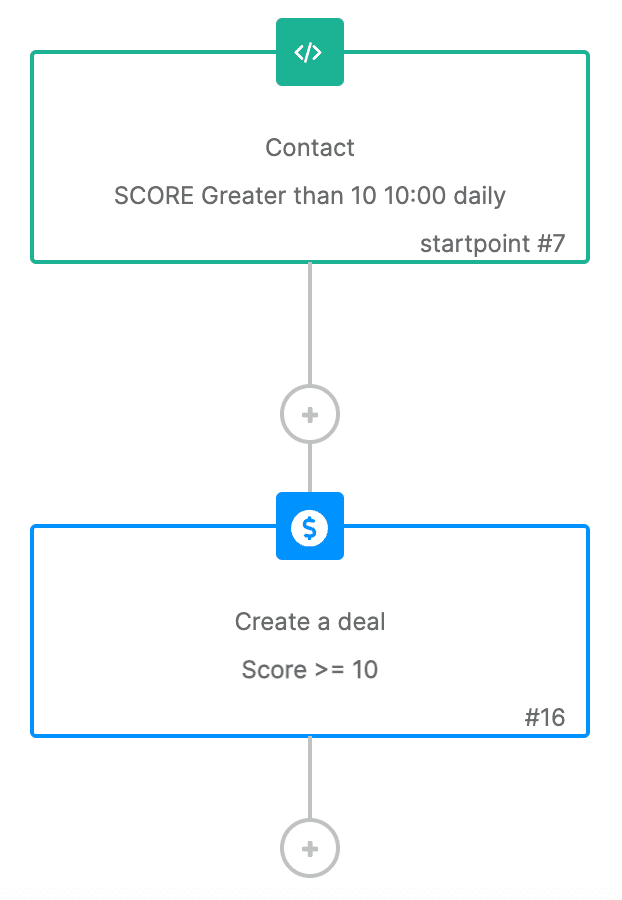
A workflow for automated deal creation in Brevo
Brevo's workflow builder allows for multi-step campaigns with branching logic. This gives you the flexibility to create highly personalized automations at every stage of the customer journey.
6. Align your sales pipeline with the sales funnel
First, what’s the difference between a sales pipeline and sales funnel? A sales funnel represents how your potential customers move toward the purchase stage. A sales pipeline focuses on the actions your sales team takes to guide them through the funnel.
Another key difference is when the prospect enters the sales pipeline. In inbound sales, a lead often moves through most of the funnel before qualifying as a sales-ready lead and entering the pipeline. In outbound sales, a lead might enter the pipeline much earlier in the funnel.
To track qualified leads and guide them toward conversion, you need to create a sales pipeline that mirrors the later stages of your sales funnel. Good news: you can do this in Brevo, too.
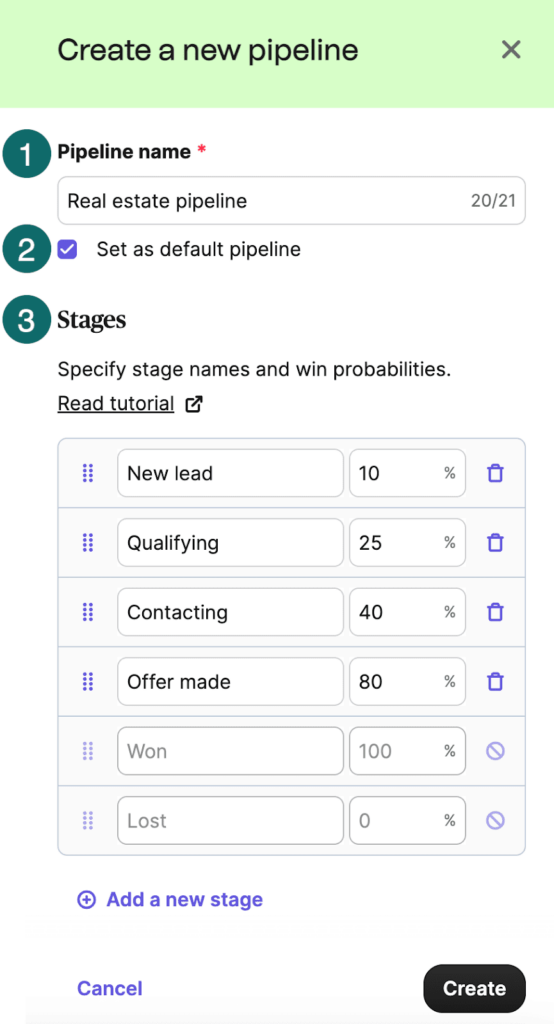
Creating a custom sales pipeline in Brevo
Start with the default pipeline or create a custom one to reflect your sales cycle. Then set up a workflow for automated deal creation. That way, qualified leads flow to your pipeline without any manual effort.
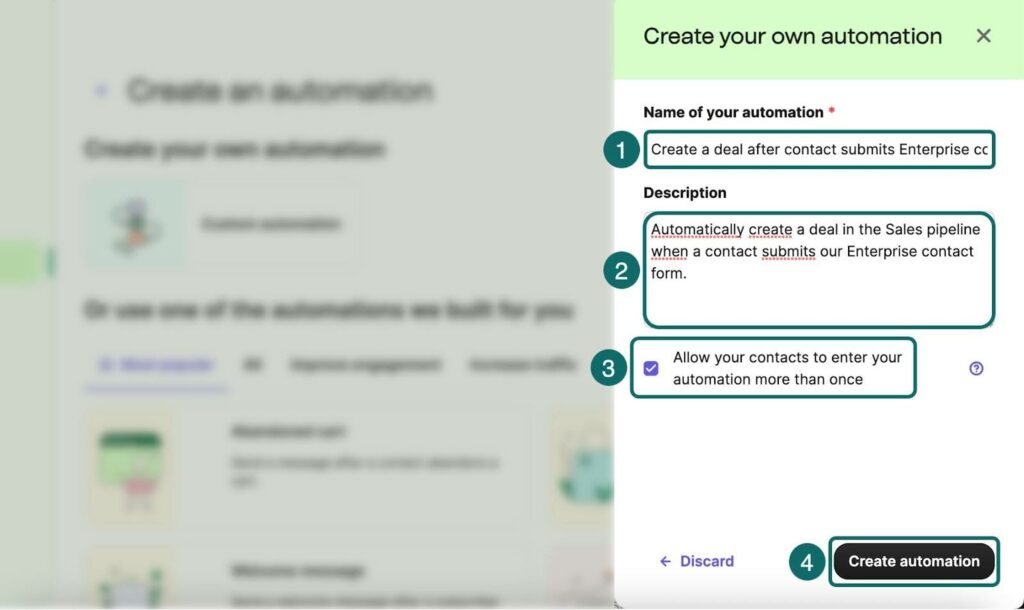
Creating a new deal in Brevo
When your leads meet the pre-defined criteria, you’ll see them land in your pipeline. It's now your team's responsibility to guide them towards a successful close.

Visual pipeline management in Brevo
Further reading: 11 Successful CRM Strategies to Grow Your Business
Move customers through your sales funnel with Brevo
A well-designed sales funnel creates a predictable path to purchase. However, you can’t manage each individual customer journey manually. That's why you need an all-in-one CRM platform.
Brevo is more than a sales funnel builder. Streamline repeat sales tasks with automation. Then organize your deals with the custom deal pipelines. With Brevo, get the tools you need to focus on what matters most — building relationships and closing deals faster.
Sign up for the Sales Platform and get core CRM features, 50 open deals, and one deal pipeline — all for free.







